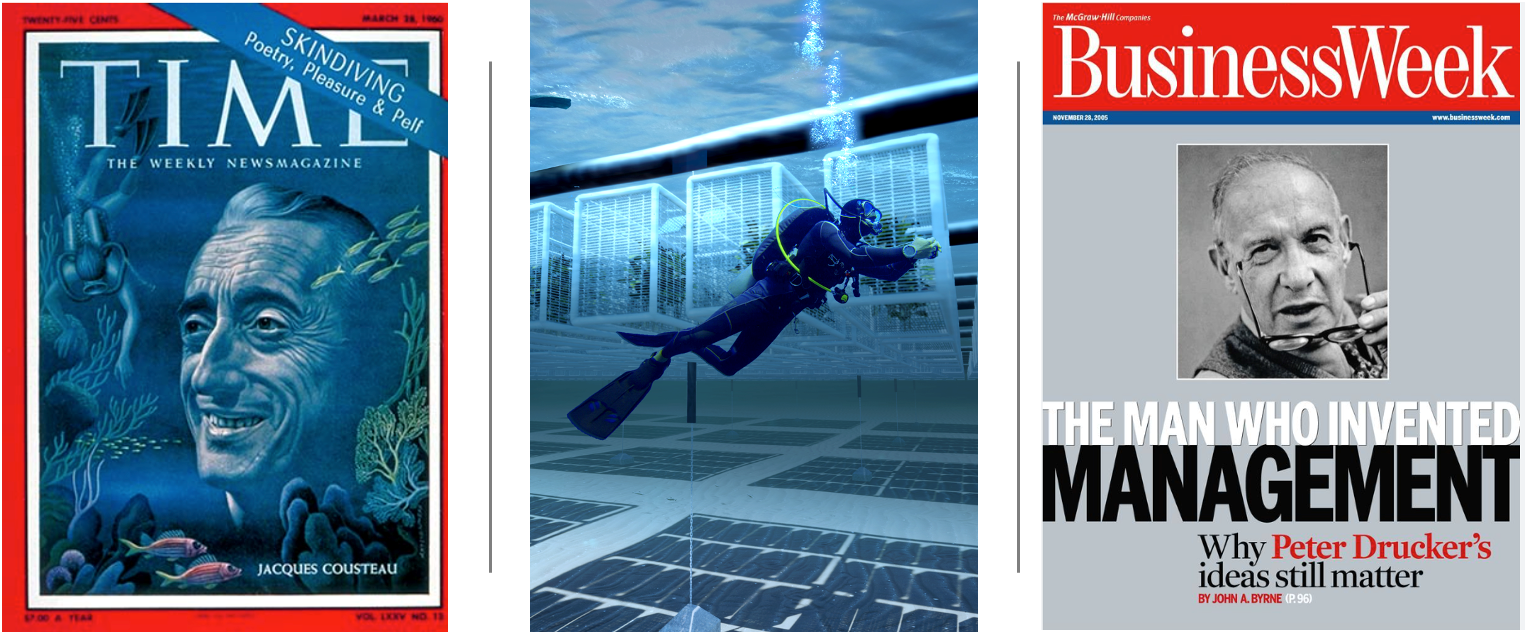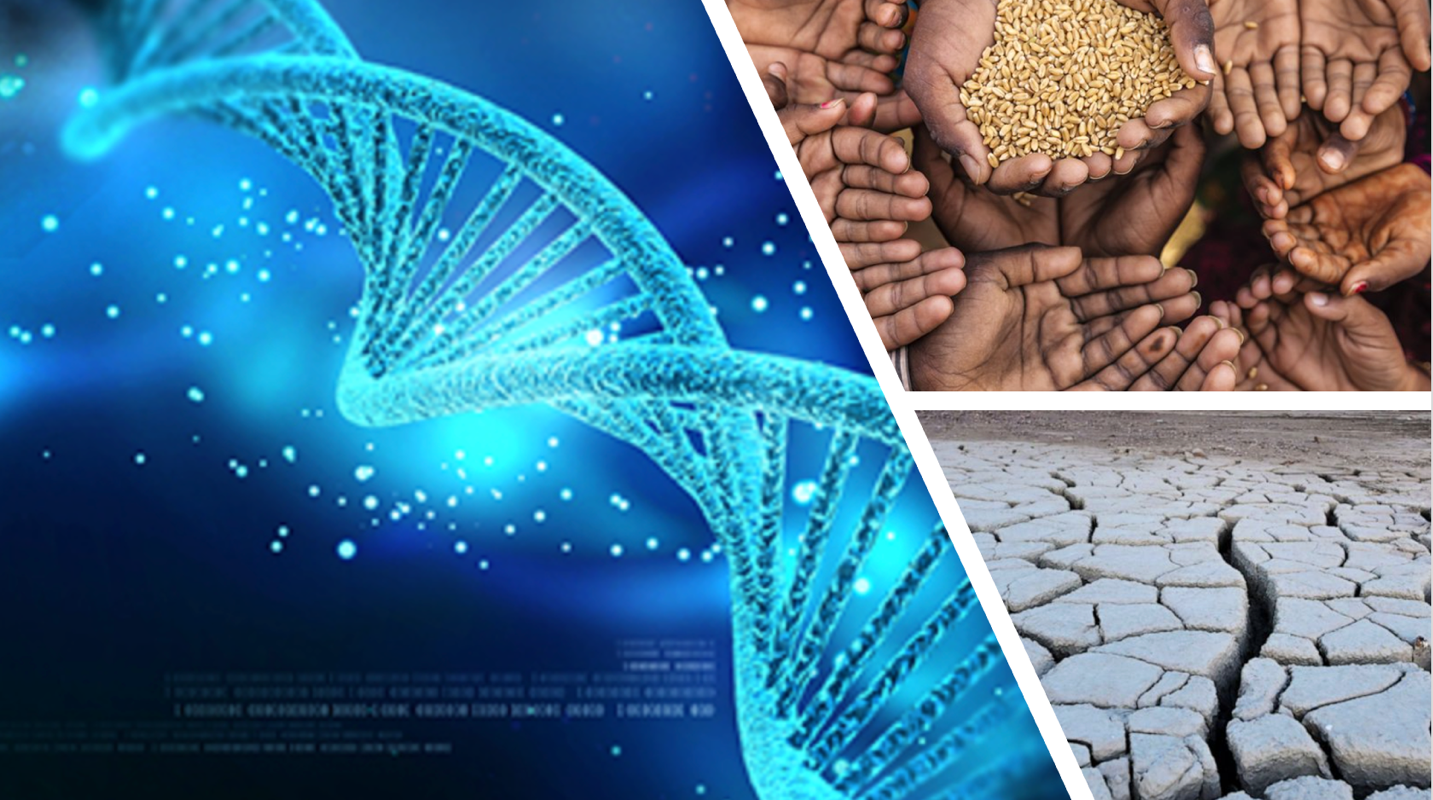Copyright © 2022 Philip C. Cruver
“Aquaculture, not the Internet, represents the most promising investment opportunity of the 21st Century” This statement was made by Peter Drucker, the management expert, economist, and Nobel Laureate: "It's going to be fish farming," he said, because on the oceans "we are still hunters and gatherers." Expanding on this opinion, Drucker said that “20 years ago all salmon and shrimp consumed was wild; today 60 percent of each is farmed, and 25 years – requires a very substantial expansion of protein supply, and expansion of terrestrial domesticated animals is becoming increasing expensive and, above all, increasingly detrimental to the environment."
Jacques Cousteau's presciently stated in 1973: "We need to farm the ocean as we farm the land". Viewing his stalled vision forty years later, perhaps Cousteau should have preceded sustainably as an adverb before farm with the conjunction that regulations must be subordinated to science-based solutions. Let’s look at the facts: since the 1970’s agriculture has been crawling at a mere 2-3% per year, while ascending aquaculture has been expanding at an average of 8% per year. The contribution of aquaculture to world fish production has grown from 3.9% in 1970 to about 35% and this growth continues, while the wild ocean fish harvest has not increased since 1990. Most of the planet’s valuable fish stocks are either fully, or over exploited, and threatened by climate and related environmental changes.
Aquaculture is the fastest growing segment of the global food sector. This shift from hunting and gathering to farming the seas promises to attract attention as controversial new paradigms emerge for the introduction of exotic species, selective breeding, and genetic engineering for feeding a future population of 9 billion. An estimated one billion of the global population today are malnourished and hungry. A revolution for producing life-sustaining protein will be critical for preventing mass genocide of the next two billion who will mostly be born in developing countries.
Planet Earth does not have the carrying capacity to feed the projected future population; however, Planet Ocean could with 70 percent more space from the sea. About 70,000 square kilometers of agricultural land are lost annually to growth of cities and other non-agricultural uses; and consumer diets in developing countries are increasingly changing from plant-based proteins to animal protein, a trend that requires a greater amount of crop-based feeds.
On Planet Earth, 18% of the land mass is used for agricultural production and ten crops account for 70-80% of all calories consumed. Agricultural land cannot be increased substantially, and all ten crops must double to meet demand. Therefore, it is only possible that the yield per unit of land be increased beyond current levels with new sustainable paradigms. The oceans are over-fished and can only yield steadily decreasing returns.
Aquaculture may be the only solution towards meeting the widening gap in demand and decreasing supply for seafood. Asia, the epicenter of the aquaculture industry, accounts for over 90% of global aquaculture production and about 80% of the value. Although China produces about two-thirds of the world’s seafood, it is projected to soon shift from a net seafood exporter to a net seafood importer. Since imports constitute about 85% of the seafood consumed in the United States, this shift in China threatens a significant supply and pricing eruption.
As the global demand doubles for food over the next 40 years, under present production technologies, achieving global food security will require a doubling of water consumption levels. Meanwhile, the chemically fueled “Green Revolution” has run its course, leaving soil moistures depleted, and unclear climate change patterns threaten a looming agricultural water crisis. According to a study by McKinsey, a third of the world’s population lives in regions facing water shortages; by 2030 global water requirements could be as much as 40 percent higher than the currently accessible supply.
Ironically, as stated previously, 70% of our planet is covered with seas offering more economical protein production not depleting scarce water resources. Also previously stated, global wild fisheries have reached or exceeded their maximum sustainable harvest. The United Nations is projecting a 40 million ton seafood shortage by 2030. Therefore, the $50 billion worldwide marine aquaculture will continue to be the fastest growing form of food production in the world.
Marine species feeding low in the food chain efficiently utilize natural resources. Each level up the trophic food chain inflates costs related to the use of such resources affecting the production of waste and the maintenance of water quality. For developing nations, low-trophic shellfish mariculture has the potential to become the next agriculture, particularly for regions confronted with water shortages and possessing ideal coastal conditions.
Shellfish as a seafood represents 27 percent of global aquaculture production. Fast growing shellfish crops require little attention as they feed on drifting plankton and are easily harvested and processed with a long shelf life for extended distribution. In contrast to traditional shellfish farming that takes place in congested and increasingly polluted bays and estuaries, the new paradigm of open ocean farming cultivates shellfish in pristine offshore waters. The abundance of plankton from the phenomenon of upwelling provides the food for rapid shellfish growth and the cool water currents deter disease.
The development of global shellfish aquaculture would increase food security by mitigating malnutrition with healthy seafood protein while also reducing the depletion of sparse water resources used for traditional agriculture. Such a sustainable new industry would create jobs, income generation, and exports for increased foreign exchange. It would also relieve pressure on wild fish stocks to revive the livelihoods of fisher folks in coastal communities
Unlike all other forms of marine aquaculture, commercially grown shellfish have been identified as the only sustainable form of aquaculture with no negative impact on the environment. Shellfish aquaculture operations improve water quality by filtering out pollutants, sediments, and plankton from the water column. Furthermore, bivalve shellfish remove nitrogen from the water to help control and prevent harmful algal blooms that are increasingly threatening coastal waters.
Bivalve shellfish and macroalgae (seaplants) are documented to synergistically improve water quality and reduce Harmful Algal Blooms (HABs) caused by nutrient overloading. Shellfish function to reduce nutrients and abate hypoxia in two ways. First, shellfish assimilate a large percentage of what they consume. Thus, shellfish cultivated and then removed for consumption would serve the purpose of extracting organic particle bound nutrients based on what they assimilate. Second, because shellfish filter-feed from the water column, they play a role in focusing where and when organic particle bound nutrients from the water column not assimilated reach the sediment bed.
Seaplants, on the other hand, uptake and assimilate dissolved inorganic nutrients making them unavailable for phytoplankton growth. The uptake of inorganic nutrients by seaplants rather than phytoplankton has the potential to abate hypoxia if the seaplant and the incorporated nutrients are removed prior to senescence and die-off. The functioning of shellfish and seaplants are complementary rather than competitive since each uptake different nutrient phases, particulate organic and dissolved inorganic.
In contrast to shellfish conventionally harvested from the bottoms of intertidal bays and estuaries that are increasingly polluted, “open ocean” is an emerging concept for cultivating shellfish in pristine offshore waters that feed 24/7. The abundance of plankton and algae from upwelling seas provide abundant shellfish food for rapid growth and the cool water currents deter disease. Because they require no fresh water, no deforestation, and no fertilizer -- all significant downsides to land-based farming -- these ocean farms promise to be more sustainable than even the most environmentally sensitive traditional farms
Seaplants are one of the fastest growing organisms in the world with turbo-charged growth cycles enabling rapid scale-up of their carbon sinks. Seaplants grown to offset emissions must be harvested and permanently consumed for certification as carbon-neutral ensuring that the carbon is not simply recycled back into the air. Seaplants employ photosynthesis to suck massive amounts of carbon deposited from the atmosphere into coastal ecosystems and amazingly can absorb five times more carbon than land-based plants. While most of the attention to carbon sinks has been on terrestrial forests, researchers are increasingly investigating the oceans where about 8 million tons of seaweed are annually harvested from wild or cultivated sources. Some scientists say seaplants could also be a potent weapon against climate change by sucking damaging carbon dioxide from the atmosphere at rates comparable to the mightiest rain forests.
Integrated multi-trophic aquaculture (IMTA), or polyculture, is a concept that encourages greater environmental stewardship for increasing the economic and environmental benefits provided by sustainable marine crops. It is based on the concept of recycling nutrients and efficient nutrient utilization. Instead of growing only one species (monoculture) and focusing primarily on the needs of that species, it mimics a natural ecosystem by combining the farming of multiple, complementary species from different levels of the food chain.
With IMTA, growing sustainable species close together benefits both the crops and the environment. The integrating of fed aquaculture with inorganic and organic extractive aquaculture (seaweed and bivalve shellfish) the wastes of one resource becomes a resource (fertilizer or food) for the other. The IMTA concept provides nutrient bioremediation capability, mutual benefits to the co cultured organisms, economic diversification, increased profitability, significant ecosystem services and increased societal acceptability. It could also play a significant role in reducing ocean acidification at coastal levels. The IMTA system is driven only by sunlight, natural inorganic nutrients, as well as carbon dioxide and provides efficient food provisions, nutrient extraction, and climate regulating services to the marine ecosystem.
According to the United Nations, the number of people affected by hunger has more than doubled in the past three years and almost a million people are living in famine conditions, with starvation and death a daily reality. A staggering three billion people cannot afford a healthy diet; the war in Ukraine has triggered surging food, fertilizer, and energy prices; and the most vulnerable are being battered by the pandemic, climate crisis, environmental degradation, conflict, and deepening inequalities. Sustainable and nutritious seaplant and shellfish farmed offshore could improve food security and vindicate Cousteau and Drucker’s admonitions.





